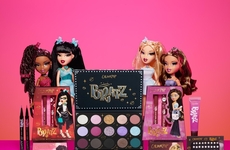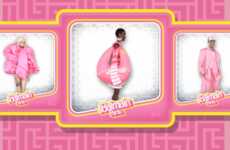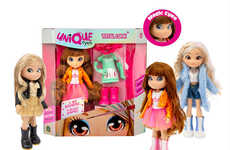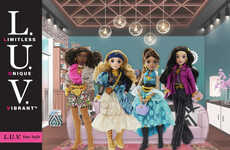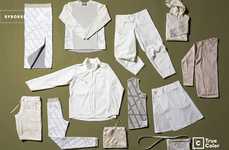
Jaime Neely — June 3, 2013 — About
References: runway.blogs.nytimes
For centuries, women everywhere have been clinging onto their youthful appearances with the help of makeup, creams, scrubs treatments and surgical procedures. These efforts, which typically start for women at some point in their thirties, are beginning to pop up at much earlier ages for girls in certain areas of the world. While women were once focused on maintaining their glowing skin from their twenties, young girls are now doing everything possible to look like the soft, porcelain-skinned dolls they played with as small children.
This desire to look like a flawless, smooth skinned and bug-eyed doll is taking the teenage and early-twenty-somethings world by storm, particularly in Eastern Europe.
In a recent article on The New York Times' website, trends expert and innovation keynote speaker Jeremy Gutsche diagnoses this infatuation as the desire of "individuals [becoming] their own models or dolls." As bizarre as it may seem to some, young girls are committing hours of their time to look like a real life doll.
Read the Full Article at The New York Times.
The New York Times
By: Ruth La Ferla
A Western variation on the Japanese penchant for dressing up as Lolita or a woodland sprite, the current dolly culture reflects an impulse that’s at fashion’s core: to offer a stringently edited, blatantly artificial version of one’s self for public consumption.
On Instagram and Look Book, and on blogs like Living Doll Culture, “individuals become their own models or dolls,” said Jeremy Gutsche, the editor of Trend Hunter, an online publication. Most remain little known, but others, pop idols like Gaga and Nicki Minaj, have had a splashy impact on the world of style. In recent months, fashion glossies featuring doll-inspired editorials included V magazine, which imported Ms. Lukyanova to model in its November issue, and Elle, whose April cover girl, Ms. Minaj, a self-professed Barbie fanatic, was decked out in its fashion pages, in jelly-bean colors and pastel wigs.
Perverse it may be, but the living doll trendlette appears to be driving sales of “candy couture,” Mr. Gutsche said, referring to an outpouring of clothing and accessories in Easter-egg tints, detailed with scalloped edges and childishly fanciful trims. And that’s to say nothing of contact lenses offered in pink, or with irises bordered in “lace.”
This desire to look like a flawless, smooth skinned and bug-eyed doll is taking the teenage and early-twenty-somethings world by storm, particularly in Eastern Europe.
In a recent article on The New York Times' website, trends expert and innovation keynote speaker Jeremy Gutsche diagnoses this infatuation as the desire of "individuals [becoming] their own models or dolls." As bizarre as it may seem to some, young girls are committing hours of their time to look like a real life doll.
Read the Full Article at The New York Times.
Such a Doll
The New York Times
By: Ruth La Ferla
A Western variation on the Japanese penchant for dressing up as Lolita or a woodland sprite, the current dolly culture reflects an impulse that’s at fashion’s core: to offer a stringently edited, blatantly artificial version of one’s self for public consumption.
On Instagram and Look Book, and on blogs like Living Doll Culture, “individuals become their own models or dolls,” said Jeremy Gutsche, the editor of Trend Hunter, an online publication. Most remain little known, but others, pop idols like Gaga and Nicki Minaj, have had a splashy impact on the world of style. In recent months, fashion glossies featuring doll-inspired editorials included V magazine, which imported Ms. Lukyanova to model in its November issue, and Elle, whose April cover girl, Ms. Minaj, a self-professed Barbie fanatic, was decked out in its fashion pages, in jelly-bean colors and pastel wigs.
Perverse it may be, but the living doll trendlette appears to be driving sales of “candy couture,” Mr. Gutsche said, referring to an outpouring of clothing and accessories in Easter-egg tints, detailed with scalloped edges and childishly fanciful trims. And that’s to say nothing of contact lenses offered in pink, or with irises bordered in “lace.”
Trend Themes
1. Living Doll Culture - The trend towards young girls emulating dolls is driving demand for candy couture.
2. Candy Couture - The stunning demand for candy couture reflects a resurgence of girlishness reflecting the core of fashion's impulse: to offer a stringently edited, blatantly artificial version of oneself for public consumption.
3. Editorials and Pop Idols - Pop icons like Lady Gaga and Nicki Minaj have already taken notice of and inspired the doll-inspired trend in fashion editorials and fashion which offers innovative opportunities for collaborations with fashion makers and influencers.
Industry Implications
1. Cosmetics - The living doll trend influenced by dolls is reforming the traditional skincare and beauty industry, creating an innovative market for younger demographics.
2. Fashion - Candy couture and the living doll trend is reshaping the fashion industry and presenting opportunities for brands to capitalize on a refreshed, thoroughly girlish image.
3. Toy Manufacturers - The trend of living dolls has opened up huge opportunities for doll makers to innovate and produce dolls that reflect current times.
0.4
Score
Popularity
Activity
Freshness



